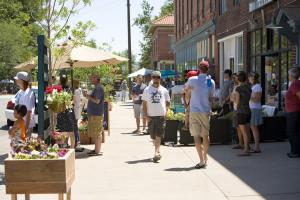Great Paths: The Boulevard at Jefferson Park
Promoting healthy living, economic vitality, and walkable neighborhoods along Federal Boulevard in northwest Denver.
Leader
Jill Locantore
Location
25th and Federal Denver, CO 80211
About the project
Like many urban neighborhoods, northwest Denver is experiencing a true Renaissance. With new restaurants and businesses opening their doors there are more places to visit and more people moving in to enjoy these amenities. Residents would like to walk to local destinations but there are many barriers such as busy streets and poor sidewalk conditions. Safety is often a concern.
The Great Paths project will promote neighborhood amenities and walking in northwest Denver through pedestrian improvements. Activities will include: an interactive community mapping exercise to identify top destinations for walking in the neighborhoods along Federal Boulevard and a priority path that links these destinations; design and installation of low-cost pedestrian improvements along the priority path such as wayfinding signs, public art, or intersection enhancements; walking tours that bring residents and visitors together to explore neighborhood amenities on foot; and, a “Walk to Dinner” event that celebrates and raises awareness of the neighborhood’s priority walking path.
The project will alert neighborhood residents and visitors to destinations that are within easy walking distance, highlight the best route for walking through the neighborhood, and enhance the pedestrian experience along that route. We will focus particular attention on the pedestrian challenge of crossing Federal Boulevard and other major roads that cut through the neighborhood. Our overarching goal is to support healthy living, economic vitality, and more walkable communities.
The Steps
- Paths and Destinations. WalkDenver and neighborhood leaders will facilitate community meetings focused on identifying the top destinations for walking in the neighborhood, and a priority path that links these destinations along a relatively safe and pleasant pedestrian route.
- Connectivity. WalkDenver and neighborhood leaders will develop and implement a plan for low-cost pedestrian improvements along the priority path such as wayfinding signs, public art, or intersection enhancements.
- Neighborhood Field Trips. This activity will celebrate and raise awareness of the neighborhood’s priority walking path, destinations, and pedestrian improvements through fun and engaging community events. WalkDenver, Walk2Connect, and neighborhood leaders will develop customized walking tours that bring residents and visitors together to explore neighborhood amenities on foot.
- Walk to Dinner Night. Together with the neighborhood field trips, this activity will celebrate and raise awareness of the neighborhood’s priority walking path, and encourage neighborhood residents to walk to local businesses.
Why we‘re doing it
Change is in the air within communities along the Boulevard. New residents, new businesses - people out and about. How often do you walk to the store, to the coffee shop, or to the park? Whether you have been here for a while or are new to the area, where do you like to go and how do you get there? How can we encourage more walking and less driving in northwest Denver?
Because everyone is a pedestrian at some point in their day, and walking is the most universal and accessible form of exercise, the benefits of walkable neighborhoods are widespread. Incorporating walking into daily routines has significant health benefits, including maintaining a healthy weight; preventing or managing various conditions including heart disease, high blood pressure, and type 2 diabetes; improving mood; strengthening bones; and improving balance and coordination. Living within walking distance of shops and services is the single best predictor of a healthy body weight.
Walkability is particularly important for the one-third of Coloradans who don’t or can’t drive, including all children under the legal driving age, people with physical or mental disabilities, about one-fifth of seniors, and many low-income Coloradans who can’t afford cars. Walkable neighborhoods also benefit small local businesses that often can’t afford to provide parking for their customers. Research suggests that businesses in walkable areas generate more revenue and contribute more in local taxes, compared to auto-oriented commercial districts.

